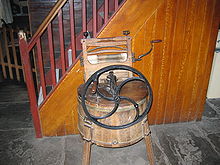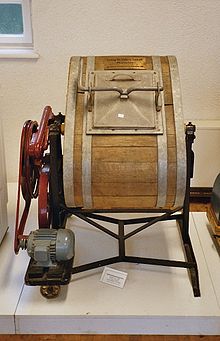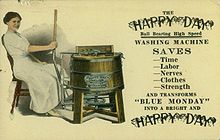A washing machine (laundry machine, clothes washer, or washer) is a machine designed to wash laundry, such as clothing, towels and sheets. The term is mostly applied only to machines that use water as the primary cleaning solution, as opposed to dry cleaning (which uses alternative cleaning fluids, and is performed by specialist businesses) or even ultrasonic cleaners. The earliest machines were hand-operated.
[edit] History
Laundering by hand involves beating and scrubbing dirty cloth. It is hard work even with manufactured aids like washboards and soap to help.
Clothes washer technology developed as a way to reduce the drudgery of this scrubbing and rubbing process by providing an open basin or sealed container with paddles or fingers to automatically agitate the clothing. The earliest machines were hand-operated. As electricity was not commonly available until at least 1930, some early machines were operated by a low-speed single-cylinder hit and miss gasoline engine. By the mid-1850s steam-driven commercial laundry machinery was on sale in the USA and Great Britain.[1] Technological advances in machinery for commercial and institutional laundries proceeded faster than domestic washer design for several decades, especially in the UK. In the US there was more emphasis on developing machines for washing at home, as well as machines for the commercial laundry services which were widely used in the late 19th and early 20th centuries.[2]
Because water often had to be carried, heated on a fire for washing, then poured into the tub, the warm soapy water was precious and would be reused over and over, first to wash the least soiled clothing, then to wash progressively dirtier laundry. While the earliest machines were constructed from wood, later machines made of ****l permitted a fire to burn below the washtub, to keep the water warm throughout the day's washing.
Removal of soap and water from the clothing after washing was originally a separate process. After rinsing, the soaking wet clothing would be formed into a roll and twisted by hand to extract water. To help reduce this labour, the wringer/mangle was developed, which uses two rollers under spring tension to squeeze water out of clothing and household linen. Each item would be fed through the wringer separately. The first wringers were hand-operated, but were eventually included as a powered attachment above the washer tub. The wringer would be swung over the wash tub so that extracted wash water would fall back into the tub to be reused for the next wash load.
The modern process of water removal by spinning did not come into use until electric motors were developed. Spinning requires a constant high-speed power source, and was originally done in a separate device known as an extractor. A load of washed clothing would be transferred from the wash tub to the extractor basket, and the water spun out.[3] These early extractors were often dangerous to use since unevenly distributed loads would cause the machine to shake violently. Many efforts have been made to counteract the shaking of unstable loads, first by mounting the spinning basket on a free-floating shock-absorbing frame to absorb minor imbalances, and a bump switch to detect severe movement and stop the machine so that the load can be manually redistributed. Many modern machines are equipped with a sealed ring of liquid that works to counteract any imbalances.
What is now referred to as an automatic washer was at one time referred to as a washer/extractor, which combines the features of these two devices into a single machine, plus the ability to fill and drain water by itself. It is possible to take this a step further, to also merge the automatic washing machine and clothes dryer into a single device, but this is generally uncommon because the drying process tends to use much more energy than using two separate devices; a combined washer/dryer not only must dry the clothing, but also need to dry out the wash chamber itself.
[edit] Milestones


19th-century Metropolitan washing machine


A vintage German model
The first English patent under the category of Washing and Wringing Machines was issued in 1691.[4] A drawing of an early washing machine appeared in the January 1752 issue of "The Gentlemen's Magazine," a British publication. In Germany, Jacob Christian Schنffer's washing machine design was published in 1767.[5] In 1782 Henry Sidgier was issued a British patent for a rotating drum washer, and in the 1790s Edward Beetham sold numerous "patent washing mills" in England.[6] In 1862, a patented "compound rotary washing machine, with rollers for wringing or mangling" was shown at the 1862 London Exhibition, done by Richard Lansdale of Pendleton, Manchester.[7]
The first United States Patent titled "Clothes Washing" was granted to Nathaniel Briggs of New Hampshire in 1797. Because of the Patent Office Fire of 1836, no description of the device exists, and it is not known what kind of washing device Briggs invented. A device that combined a washing machine with a wringer mechanism did not appear until 1843, when John E. Turnbull of Saint John, New Brunswick patented a "Clothes Washer With Wringer Rolls."[8]
Electric washing machines were advertised and discussed in newspapers as early as 1904.[9] Alva J. Fisher has been incorrectly credited with the invention of the electric washer. The US patent office shows at least one patent issued before Mr. Fisher's US patent number 966677 (e.g. Woodrow's US patent number 921195). The "inventor" of the electric washing machine remains unknown.
US electric washing machine sales reached 913,000 units in 1928. However, high unemployment rates in the Depression years hit sales; by 1932 the number of units shipped was down to about 600,000.
The first laundromat opened in Fort Worth, Texas in 1934.[10] It was run by Andrew Clein. Patrons used coin-in-the-slot facilities to rent washing machines. The term laundromat can be found in newspapers as early as 1884 and they were widespread during the depression. It is almost impossible to determine who had the first laundromat. England established public wash rooms for laundry along with bath houses throughout the 19th century.[11]
Washer design improved during the 1930s. The mechanism was now enclosed within a cabinet, and more attention was paid to electrical safety. Spin dryers were introduced to replace the dangerous power wringers of the day.
Early automatic washing machines were usually connected to the water supply via temporary slip-on connectors to the sink taps. Later, permanent connections to both the hot and cold water supplies became the norm. Most modern front-loading European machines now only have a cold water connection (i.e. cold fill) and rely completely on electric heaters to raise the water temperature.
By 1940, 60% of the 25,000,000 wired homes in the United States had an electric washing machine. Many of these machines featured a power wringer, although built-in spin dryers were not uncommon.
Bendix introduced the first automatic washing machine in 1937,[12] having applied for a patent in the same year.[13] In appearance and mechanical detail, this first machine is not unlike the front loading automatic washers produced today. Although it included many of the today's basic features, the machine lacked any drum suspension and therefore had to be anchored to the floor to prevent "walking".


1910 advertisement
Many of these early automatic machines had coin-in-the-slot facilities and were installed in the basement laundry rooms of apartment houses. After the attack on Pearl Harbor, US domestic washer production had to be suspended for the duration of World War II. However, many US appliance manufacturers were given permission to undertake the research and development of washers during the war years. Many took the opportunity to develop automatic machines, realizing that these represented the future for the industry.
An improved front loading automatic model, the Bendix Deluxe (which retailed at $249.50), was introduced in 1947.[14]
General Electric also introduced its first top loading automatic model in 1947. This machine had many of the features that are incorporated into modern machines.
A large number of US manufacturers introduced competing automatic machines (mainly of the top loading type) in the late 1940s/early 1950s. Several manufacturers even produced semi-automatic machines, where the user had to intervene at one or two points in the wash cycle. A common semi-automatic type (available from Hoover in the UK until at least the 1970s) included 2 tubs: one with an agitator or impeller for washing and/or rinsing; another, smaller, tub for water extraction or centrifugal rinsing.
One early form of automatic washing machine manufactured by Hoover used cartridges to program different wash cycles. This system, called the Keymatic, used plastic cartridges with key-like slots and ridges around the edges. The cartridge was inserted into a slot on the machine and a mechanical reader operated the machine accordingly. The system did not commercially succeed because it offered no real advantage over the more conventional program dial, and the cartridges were prone to getting lost. In hindsight it can be seen as a marketing gimmick rather than offering any really useful functionality.
Since their introduction in the late 1930s/mid 1940s, automatic washing machines have relied on mechanical timers to sequence the washing and extraction process. Mechanical timers consist of a series of cams on a common shaft. At the appropriate time in the wash cycle, each cam actuates a switch to engage/disengage a particular part of the machinery (e.g. drain pump motor). The timer shaft is driven by a small electric motor via a reduction gearbox.
On the early mechanical timers the motor ran at a constant speed throughout the wash cycle, although it was possible for the user to truncate parts of the program by manually advancing the control dial. However, by the 1950s demand for greater flexibility in the wash cycle led to the introduction of electronic timers to supplement the mechanical timer. These electronic timers enable greater variation in such functions as the wash time. With this arrangement, the electric timer motor is periodically switched off to permit the clothing to soak, and is only re-energised just prior to a micro-switch being engaged/disengaged.
Despite the high cost of automatic washers, manufacturers had difficulty in meeting the demand. Although there were material shortages during the Korean War, by 1953 automatic washing machine sales in the US exceeded those of wringer-type electric machines.
In the UK and in most of Europe, electric washing machines did not become popular until the 1950s. This was largely because of the economic impact of World War II on the consumer market which did not properly recover until the late 1950s. The early electric washers were single tub, wringer-type machines, automatic washing machines being extremely expensive. During the 1960s, twin tub machines briefly became very popular, helped by the low price of the Rolls Razor washers. Automatic washing machines did not become dominant in the UK until well into the 1970s and by then were almost exclusively of the front-loader design.


A 1950s model
In early automatic washing machines, any changes in impeller/drum speed were achieved by mechanical means or by a rheostat on the motor power supply. However, since the 1970s electronic control of motor speed has become a common feature on the more expensive models.
Early front loading machines, especially those manufactured in Mediterranean countries (e.g. Italy), had low spin speeds (e.g. 800 rpm or less). Nowadays, a spin speed of 1200 rpm is common and a peak spin speed as high as 1600 rpm is available on many machines. Now models in Europe have speeds of 1800 rpm and a few European washing machines have a spin speed of 2000 rpm. However, because they were not susceptible to gravitational forces, some early top loading machines had spin speeds in excess of 1000 rpm, although some were as low as 360 rpm. Most US top-loading washers have spin speeds less than 1000 rpm.
In the early 1990s, upmarket machines incorporated microcontrollers for the timing process. These proved reliable, so many cheaper machines now incorporate microcontrollers, rather than mechanical timers. Washing machines are a classic application for fuzzy logic[why?]. Miele, from West Germany, was the top of the line front load washer, and was introduced in Kananaskis, Alberta by Glenn Isbister starting a revolution in Laundry in Canada.
In 1994, Staber Industries released the System 2000 washing machine, which is the only top loading, horizontal-axis washer to be manufactured in the United States. The hexagonal tub spins like a front loading machine, only using about third of the water as conventional top-loaders. This factor has led to an Energy Star rating for its high efficiency.
In 1998, New Zealand based company Fisher & Paykel introduced its SmartDrive washing machine line in the US. This washing machine uses a computer-controlled system to determine certain factors such as load size and automatically adjusts the wash cycle to match. It also used a mixed system of washing, first with the "Eco-Active" wash, using a low level of recirculated water being sprayed on the load followed by a more traditional style wash. Other variations include the Intuitive Eco, which can sense the water level and type of fabric in the wash load, and the agitatorless AquaSmart line.
In 2001, Whirlpool Corporation introduced the Calypso, the first vertical-axis high efficiency washing machine to be top-loading. A washplate in the bottom of the tub nutated to bounce, shake, and toss the laundry around. As this happened, water containing detergent was sprayed on to the laundry. The machine proved to be good at cleaning but gained a bad reputation due to frequent breakdowns and destruction of laundry and the washer was recalled with a [[class-action lawsuit][citation needed]] and pulled off the market.
In 2003, Maytag introduced their top-loading Neptune washer. Instead of an agitator, the machine had two washplates, perpendicular to each other and at a 45 degree angle from the bottom of the tub. The machine would fill with only a small amount of water and the two washplates would tumble the load within it, mimicking the action of a front-loading washer in a vertical axis design.
In the early first decade of the 21st century, the British inventor James Dyson launched the ContraRotator, a type of washing machine with two cylinders rotating in opposite directions; which, it is claimed, reduces the wash time and produces cleaner results; however, this machine is no longer in production.
In 2007, Sanyo introduced the first drum type washing machine with ‘Air Wash’ function.[15] This washing machine uses only 50l of water in the recycle mode.
In 2008, the University of Leeds created a concept washing machine that uses only a cup (less than 300ml) of water to carry out a full wash. The machine leaves clothes virtually dry, and uses less than 2 per cent of the water and energy otherwise used by a conventional machine, but requires 20 kg of re-usable plastic chips in each load. As such, it could save billions of litres of water each year.[16]
Features available in most modern consumer washing machines:
- Predefined programs for different laundry types
- Variable temperatures including cold wash
- Rotation speed settings
- Delayed execution: a timer to delay the start of the laundry cycle
Additionally some of the modern machines feature:
- Child lock
- Time remaining indication
- Steam


![]() ( تقرير عن مشاركة سيئة )، و الموجودة أسفل كل مشاركة .
( تقرير عن مشاركة سيئة )، و الموجودة أسفل كل مشاركة .